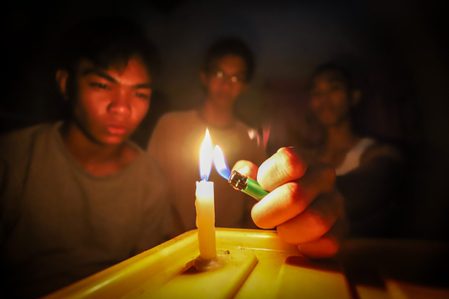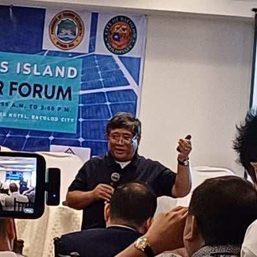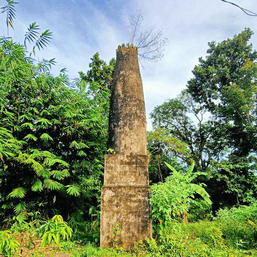SUMMARY
This is AI generated summarization, which may have errors. For context, always refer to the full article.
![[OPINION] Panay pretexts and power plays](https://www.rappler.com/tachyon/2024/01/panay-power-blackout-january-17-2024.jpg)
Most of the calls for accountability for the system-wide blackouts that swept over Panay follow a playbook systematically unfolding against the National Grid Corporation of the Philippines (NGCP), the corporation that holds the operate and maintain (O&M) franchise of assets owned by the National Transmission Corporation (Transco). The O&M privatization followed the Arroyo administration’s Electric Power Industry Reform Act (EPIRA).
Given the terrible mess we now suffer in the energy industry, our continuing dependence on dirty and dollar-depleting fuels, the shortage of adequate baseload capacity, unaffordable electricity rates that double outside the Luzon franchise areas despite the presence of nationwide subsidies, the lack of competent policy-making officials and regulators, and the prevalence of crony and oligarchical rent-seekers, EPIRA now seems to be one of the worst laws ever woven and passed.
Ironically, among its weavers, one sewer at the National Economic and Development Authority (NEDA) now presides over it. So are a number of the lawmakers behind it still among those influencing the current Marcos administration. Worsening the irony, these presidential whisperers include those who wove into EPIRA the privatization of Transco’s O&M to operating and transmission technology providers with an umbilical to a hostile foreign state.
The Sinophobia behind the blame-game surrounding the Panay blackouts is undeniable. Latent geopolitical tinderbox realities warped from economic dependence under the Arroyo administration to an adversarial schizophrenia between China and the Philippines. It does not help that the switches and dials controlling the transmission monopoly is in the same hands as those squeezing the triggers of water cannons in the West Philippine Sea.
Equally undeniable but tragically hilarious are proffered precipitous propositions by energy officials sparked by the Panay polemics that the O&M portion of the Transco privation be revoked and re-bid.
Why is that funny? It was proposed by factotum complicit in the privatization to a foreign state in the first place. How spineless is that where the inconsistency and betrayal of primary principles threaten serious constitutional consequences?
Of lesser concern are consequences threatening potential Build, Operate, and Transfer (BOT) foreign investment where investors undertake CAPEX expansion but are denied sufficient profit and loss venues to recoup from risks taken and capital assets spent on.
The Panay blackouts are archetypal microcosms of incompetent energy governance from the Arroyo administration now reprised under Ferdinand R. Marcos. From the current Panay patsy being demonized to pretexts and power plays involving corporate acquisitions that seasoned professionals see through, allow us to analyze the Panay outages based on its factual details set against established and automatic grid code responses previously formatted under far more competent regulatory administrations. Finally, let us see what should have kicked-in within hours, instead of the systemwide collapse suffered by Panay.
When two Panay generating units went offline (one on scheduled maintenance, the other from a pump problem), the grid remained balanced enough to continue without collapsing. To prevent a tripping cascade, a load-dropping system typically kicks-in where automatic load dropping (ALD) or manual load dropping (MLD) protocols prevent a systemwide collapse.
Low megawatt plants cannot trip higher baseload megawatt plants. Since a 150-MW unit was already on scheduled maintenance, its size alone triggers a red alert status. Thus, the only unexpected variable that could cause a cascading trip was the 82-MW unit with a pump problem.
And yet officials would have us believe that a small offline 82-MW unit tripped a larger 135-MW coal-plant and four others thus collapsing the whole grid affecting Aklan, Antique, Capiz, Guimaras, and Iloilo. That’s ridiculous.
Unfortunately, the privately-owned distribution utility (DU) that had recently taken over from the previous Panay Electric Corporation (PECO, the Panay equivalent of Meralco) failed to switch to either ALD or MLD despite the red alert status. Throughout the tripping cascade, for over two hours, no ALD or MLD was implemented despite being based on constantly calibrated system frequencies at DU (not transmission) substations to prevent a collapse beyond the grid.
The takeover of PECO had set the basis for the expansion of its politically-granted franchise area which eventually included the acquisition of three electric cooperatives (ILECO 1,2, and 3) previously under the Iloilo Electric Cooperative (ILECO).
Had ALD or MLD been activated upon the DU’s initiative once 82-MW went offline, power should have been restored within hours depending on the fuel-type of the generating units where coal-fired plants like the tripped 135-MW unit can take from several hours to half a day while diesels like the DU’s own barge units can fire up within an hour.
![[OPINION] Panay pretexts and power plays](https://img.youtube.com/vi/2w6Q2lRRVZM/sddefault.jpg)
Curiously, in intervals, the Panay blackouts lasted for more than a day. Given the long-prevailing thin market capacity and ancillary reserves from Panay’s already inadequate baseload capacity and its dependence on only two in-island major baseload sources, what the generator (Panay Energy Development Company) should have done upon the red alert raised by NGCP was to coordinate directly with its DU to operationalize the DU’s ALD or MLD as is the protocol in the Luzon franchise. That did not happen.
The Panay systemwide grid collapse that blacked-out even the expanded DU franchise areas was a resource and supply dependability problem. Not only were grid-balancing ancillary reserves insufficient in Panay as they were centered mostly in Cebu but the whole Visayas has the lowest planning reserve margin (PRM) with absolutely no resource adequacy ratio (SAR) study. Pre-determining both, as is typical globally, is the responsibility of policy and regulatory officials concomitant with their duty to periodically re-reprice transmission and distribution utility rates to compel and enable asset and systems upgrades.
Instead, the DOE, regulators and bully pulpit grandstanders blame their go-to private-sector patsy ignoring the reality that sufficient baseload has not been added to the Panay grid. The finger-pointing likewise ignores the regulator’s failure to periodically re-calibrate rates where returns on the mandated weighted average costs of capital (WACC) allow either upgrading the Cebu-Negros-Panay submarine cable or ensure sufficient on-grid ancillary reserves.
As it stands, due to regulatory dereliction and the DOE’s failure to attract adequate onsite market capacity for Panay, relying mostly on the current un-upgraded submarine cable, NGCP can only supply 19% of Panay’s needs. – Rappler.com
Dean de la Paz is a former investment banker and managing director of a New Jersey-based power company operating in the Philippines. He is the chairman of the board of a renewable energy company and is a retired Business Policy, Finance, and Mathematics professor. He collects Godzilla figures and antique tin robots.
1 comment
How does this make you feel?











This is alarming. What if what happened to Panay simultaneously occurs in all parts of the Country? What if such a nationwide brownout occurs during China’s invasion of Taiwan? Or during a war between Philippine and Chinese naval forces in the West Philippine Sea?